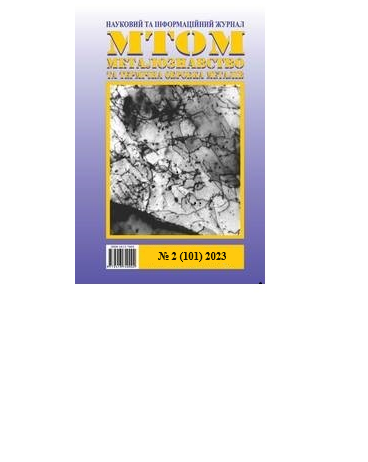RESEARCH OF PRODUCTION TECHNOLOGY AND PROPERTIES OF THE BLADE IS MADE BY THE MINE WELDING METHOD
DOI:
https://doi.org/10.30838/J.PMHTM.2413.040723.7.979Keywords:
composite, austenite, heat treatment, empering, substructure, ear resistance, annealing, carbidesAbstract
Problem statement. One of the main requirements for the blade is to achieve significant indicators of corrosion resistance and elasticity, the ability to withstand lateral and contact loads. Thanks to the combination of high-carbon and stainless steels with the help of pit welding, the effect of zone hardening is achieved in the subsequent heat treatment. Zone hardening technology is a combination of different hardness indicators on one knife blade, which leads to a significant increase in the elasticity and durability of the blade, reduces the risk of hardening cracks. Mine welding allows you to combine into a composite steels that have a high content of carbon (С = 0,9…1 %, С = 0,4…0,45 %) and chromium (Cr = 13…14 %), which with an ordinary electric arc method is practically impossible to do. High carbon equivalent and chromium doping complicates existing welding processes. With the appropriate modes of thermoplastic deformation, we get in the zone of forge welding a monolithic connection of two steels at the atomic level, which in itself is already a composite (combination of two materials with different properties to obtain a third starting material). Materials and methods. Etching the blade in an acid solution. To obtain blanks for blacksmithing (pit welding), we took steel bar ШХ15Ш (ТУ141594 DSTU4738:007) Ø – 20 mm, length L − 80 mm for the cutting part of the blade, steel bar 40Х13 DSTU 7838:007, for covers Ø − 20 mm, L − 150 mm. The total weight of the package is 0,42 kg. The results of the experiment. When conducting four experimental attempts to determine the tempering temperature-time regimes for a composite knife blade (ШХ15Ш in 40Х13 facings), the following parameters were obtained: 1. heating temperature 260…270 °С; 2. exposure for 1,8…2 hours; 3. cooling − air. The hardness of the blade is 58−59 HRC, the cutting part is 52−54 HRC of the coating. With such indicators, the maximum indicators of wear resistance of the cutting edge and high indicators of blade elasticity were obtained. For steel n690: 1. heating temperature for tempering 200…220 °С; 2. exposure for 1 hour; 3. cooling − air. Conclusions. Knife blades are proposed to be made by manual forging, without the use of pneumatic and hydraulic hammers, to ensure the purity of the experiment. The work includes calculations of heat treatment regimes, analysis of the microstructures of the obtained monosteel and composite, economic feasibility, advantages and disadvantages of one method of obtaining a blade blade over another.
Downloads
Published
Issue
Section
License
Authors that are published in this journal agree to follow the conditions:
Authors reserve the right to the authorship of his work and cede the right to the journal of first publication of this work on conditions of the license under the Creative Commons Attribution License, which allows others to distribute it freely with the obligatory reference to the author of the original work and the first publication of the work in this journal.

